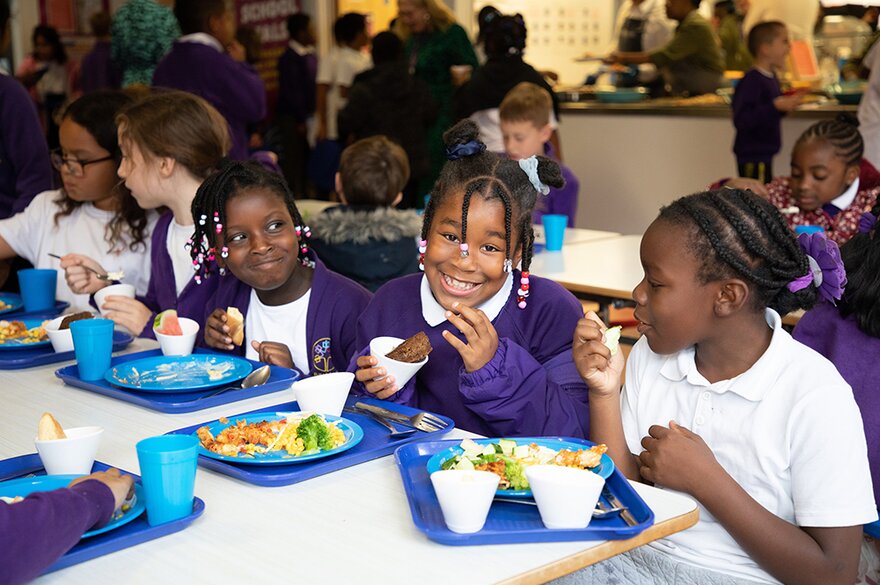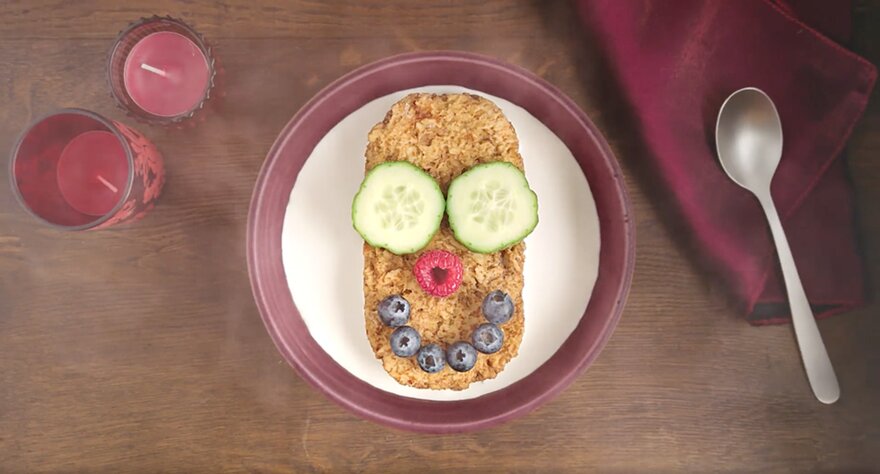Kids and parents are turning the children's menu down in favour of ‘adult' food in smaller portions
How do you convince children to eat ox tongue? Chantelle Nicholson, chef-owner of Mayfair's Apricity, has a better idea than most. "I think for some children it's exciting because it's, ‘oh we're eating tongue, that's kind of gross'," she says with a chuckle. "But the way we cook it, it's tasty, it's interesting, the texture is not how you might have had it as a kid… it's a great learning experience."
Apricity, which has a Michelin green star, launched a five-course ‘Culinary kids' tasting menu in January, following on the heels of a similar project at Nicholson's previous restaurant, Tredwell's in Covent Garden. The menu features a huge variety of ingredients, flavours and textures, including sea buckthorn, crispy oyster mushrooms, roasted cauliflower and yes, ‘Cheswell Grange ox tongue'. It's a tour de force of imaginative but earthbound cooking and exactly the sort of thing that will thrill adventurous kids.
In the modern restaurant world, there is a potent divide over the purpose of children's food. For some, it's a way of gently introducing children to the world of hospitality, while – let's be honest – giving parents and carers some certainty they won't hear ‘I don't like it' and a guarantee they will get to enjoy their meal in relative harmony. For others like Nicholson, it's part of a bigger campaign to engage kids with what they're eating and to help introduce them to the wide world of food and flavour.
Parents and carers may sympathise with the latter, but perhaps they lean towards the former when it comes to parting with their cash. So what can operators do to ensure they get it right when it comes to children's food and drink?
Shifting perceptions about food for children
Nicholson's motivation to tackle kids' food came out of a desire to shift perceptions. "I guess I wasn't too enamoured with what's on offer for kids in restaurants," she says. "It's so different from the reality of what food is about. Parents, carers, family members can come and have an enjoyable experience – I wanted children to have that, to have something that is more than just fuel."
She says the reaction has been pleasing – "kids find out they like certain things and they really don't like certain other things" – and that there's great value in challenging the dominant narrative when it comes to childrens' food.
"So often, children have the same voice talking at them," she says. "Sometimes it's nice to have a different voice, to help open their minds up a little bit more."
As Nicholson acknowledges, the kids who get to eat at Apricity come from a certain demographic, brought along by adults who can afford it and for whom good food is an important part of life. That's not true of every British child, but the menu's greater purpose – illustrated by coverage in the national press – is to raise the issue in the public consciousness.
For every meal sold, 50p goes to the Alexandra Rose Charity, which helps families buy fresh fruit and vegetables, while all proceeds from the restaurant's cooking and learning sessions go to School Food Matters, a charity teaching kids about food with the aim of improving access to healthy, sustainable food while at school. It's crucial work at a time when, according to the think tank Food Foundation, almost four million British children are in food poverty.
Apricity is not alone in offering something a bit different, even if the motivation might not be quite the same. Sticks'n'Sushi, the Danish group which now has 11 UK restaurants, mostly in London, offers a kids menu that reflects what the adults eat, including sushi but not including ginger or wasabi.
"For me, it's about understanding where food comes from and how it gets onto our plate," says Nicholson. "It's quite important to be able to understand the hard work that's involved in that [and to understand] that with climate change we're going to see a lot of other changes. Also, there's the nutritional aspect; what it does to your body. I try to use as many vegetables and as many pulses as possible and to present them in a delicious way."
Children, it's believed, have a higher concentration of taste buds than adults, which can make strong flavours a problem, but texture can be just as big an issue. Carers and parents of autistic children, in particular, know about this. For Nicholson, there are certain textures that can be particularly difficult, although they also offer a fun learning experience for kids.
"Mushrooms are always a bit of a tricky one," she says. "We do them as different textures on the plate. It's a good way to introduce something in a different format and it's interesting for adults as well as children to eat an ingredient prepared in a different way.
"One that's come up recently, and it's my ingredient of the moment, is marrowfat peas. If you take a marrowfat pea and cook it from dried, it's a very different taste and texture to a mushy pea from a can. I think people associate them as different things."
Children's meals at school
Nicholson is not the only one making the connection between what children eat in restaurants and what they eat at school. Education catering company Chartwells runs a scheme called Beyond the Chartwells Kitchen, which is "designed to empower pupils with an ever-evolving toolkit based on five key themes: nutrition and health, cooking and food, mental wellbeing, sports and exercise, and sustainability". Chartwell says 10,000 kids attend a workshop each month.
Full Time Meals, a collaboration with chef Tom Kerridge, took place last autumn at Torridon primary school in Lewisham, London. Kerridge helped cook lunch with the kitchen team, creating Mexican-style chicken, carrot and courgette spaghetti and tortilla pizzas, all recipes from the Full Time Meals initiative.
The enemy is ultra-processed food (UPF), which is increasingly ubiquitous in British cooking, even if some UPF is not as bad as others. Tess Warnes, dietician at independent food procurement specialist Allmanhall, says there needs to be a whole cultural shift. "As a starting point, we should focus on whole foods as much as possible," she says.
Cost is a barrier for operators as much as customers, particularly given the current parlous economic situation. This presents a potential opportunity when it comes to older children, according to Holly Rogers, research and insights manager at Bidfood, which in October last year carried out a survey among parents and children into food and drink choices when eating out.
"What is striking is that parents appear to be looking for something in the middle, a halfway house between the kids menu and the adult one," she says. "A huge 79% of parents say they'd be happy to order options from the main menu if they came in smaller portions for children and 44% of children would rather have a meal from an adult menu."
The demand for healthier ingredients has driven the rise of a number of products like Real Good Ketchup, which has no added sugar. "There's a growing motivation among parents to find new ways to reduce sugar and salt in their children's diets without depriving them of the foods they love," says founder Elizabeth Jones. "Healthier alternatives are the way forward, with simple and delicious swaps becoming a game changer, both for parents and caterers."
Some families are eating less meat, too. "The way we feed our children has shifted significantly over the last few years, with many more households going meat-free and looking for meat alternatives when eating out, this is being passed down to the younger generation," says Phil Thornborrow, foodservice director at Quorn.
Give the children what they want
Weetabix is a staple of British breakfasts and should be on any operator's list, says David Bone, foodservice channel manager. "Our purpose is to help the family live better lives by providing better breakfasts, drinks and snacks," he says. "We're passionate about helping families to not only start their day in the best way, but to continue it. What's more, we are committed to doing this in a sustainable, responsible way. It's in our DNA."
And what about spice? It's a big part of the British diet, for kids as well as adults. EHL Ingredients suggests its Lähde blends, such as its barbecue seasoning, Cajun, churrasco and chimichurri blends, which all add savour to food without being overwhelmingly hot.
"Children's palates have evolved and while many outlets offer the standard chicken nuggets and fish fingers, we're seeing that many younger diners are open to exploring world foods and are curious to try exotic flavours," says Kath Davies, new product development manager of Lähde brand by EHL Ingredients.
Children's food remains fairly conservative compared to much else that is going on in hospitality, but Nicholson remains optimistic: "I hope things are changing," she says. "I think the industry's current challenges aren't helping in terms of staffing costs, but actually a lot of the foods we use are more affordable. There needs to be a sense of responsibility in terms of what we're feeding our kids."
Suppliers
Allmanhall allmanhall.co.uk
Bidfood www.bidfood.co.uk
Chartwells www.chartwells.co.uk
EHL Ingredients www.ehl-ingredients.co.uk
Quorn www.quorn.co.uk
Real Good Ketchup realgoodketchup.com
Weetabix weetabix.co.uk
Continue reading
You need to be a premium member to view this. Subscribe from just 99p per week.
Already subscribed? Log In






